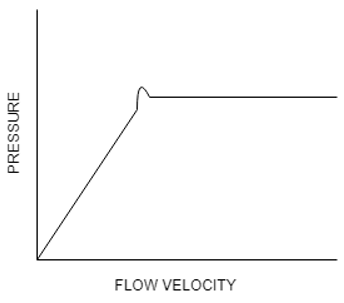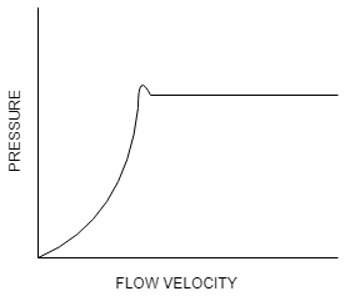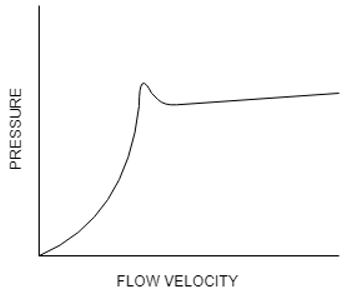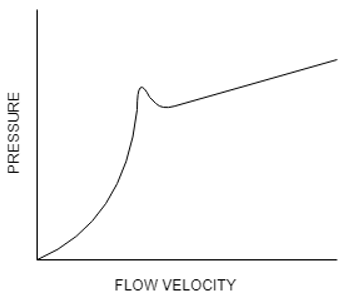This set of Tricky Heat Transfer Operations Questions and Answers focuses on “Fluidised Beds – Heat Transfer Coefficients”.
1. Which one of the following diagrams is the correct representation of pressure drop in fluidised bed?
a) 
b) 
c) 
d) 
View Answer
Explanation: The pressure drop in fluidised bed increases to a maximum value when fluidisation occurs and then becomes constant.
2. The maximum velocity of the turbulent regime is called the ___________ at which the fast fluidization regime occurs.
a) Terminal velocity
b) Transport velocity
c) Superficial velocity
d) Average velocity
View Answer
Explanation: The fast fluidisation regime is reached long after fluidisation is achieved, here the turbulent region is at its maximum, and hence this flow velocity is known as the transport velocity.
3. What happens at velocities above the transport velocity?
a) Particles coagulate
b) Particles are carried out of the system by the fluid
c) Particles break into smaller parts
d) Particles accumulate at the top
View Answer
Explanation: When the velocities reach above the transport velocity, the particles are carried out of the system by the fluid and the bed can only be maintained by feeding new particulate material into the setup.
4. Which one of the following working model is best suited for fluidized bed combustion boilers?
a) Bubbling fluidized beds
b) Laminar film fluidised bed
c) Pneumatic conveying regime
d) Moving bed (Dense flow)
View Answer
Explanation: As the question suggests, fluidized bed combustion boilers commonly use bubbling fluidized beds or turbulent regime to manage the fly ash properly and to have an economic model for long term use.
5. Parameters that describe the overall behaviour of the fluidized bed in the bubbling regime are:
(i) minimum fluidization velocity,
(ii) Pressure drop across the bed,
(iii) Bed height increase,
(iv) Particle elutriation.
a) (i) (ii)
b) (ii) (iii) (iv)
c) (i) (ii) (iii) (iv)
d) (i) (ii) (iii)
View Answer
Explanation: All the statements mentioned are correct. Examining each statement, when we have the bubbling regime for Gas-solid fluidised bed, the parameters that govern the bubbling is necessarily its pressure drop, that determines the flow velocity as well as the bed height increase, and vice versa, all the four points are interconnected.
6. Which one of the following method is the most reliable when it comes to determine fluidisation point?
a) Pressure Drop
b) Top surface particles starting random movement
c) Half of the particles getting free
d) All particles are free
View Answer
Explanation: Pressure drop is the most reliable method to determine whether the bed has reached fluidisation or not by examining the graph plot when the pressure drop becomes constant.

7. What is the correct expression for pressure drop in a fluidised bed at fluidisation?
a) ΔP=(1-∈)(ρP-ρg)gHB
b) ΔP=(∈)(ρP-ρg)gHB
c) ΔP=(1-∈)(ρP-ρg)gHC
d) ΔP=(1-∈)(ρP)gHB
View Answer
Explanation: At fluidisation, the pressure drop equals the weight of the particles, which is its weight per unit area of cross section of bed which is (ρP-ρg)gHC. The term ∈ here stands for the porosity of the bed.
8. If the operation on a fluidised bed is a dense flowing fixed bed, then which one of the following method is used for pressure drop calculation?
a) Sieder Tate Equation
b) Ergun Equation
c) DeMentic Equation
d) Kozeny Carman Equation
View Answer
Explanation: Sieder Tate equation is used for flow without any particles, Kozeny Carman is for laminar flow regime in packed beds, and hence we use Ergun equation which is best suited as it was derived for turbulent packed beds.
9. Which one of the heat transfer processes are not involved in a fluidised bed?
a) Gas-wall heat transfer
b) Heat transfer between different points in the bed
c) Heat transfer between the fluidized bed particles and the larger particles floating in the bed
d) Heat transfer to the submerged surfaces in contact with the bed
View Answer
Explanation: In fluidised beds, wall heat transfer does not take place, this particular design is exclusive to packed beds. Rather fluidised beds have reactive solids which react, produce heat and leave the bed immediately.
10. On complete fluidisation, which one of the following is zero?
a) Gas-particle heat transfer
b) Heat transfer between different points in the bed
c) Heat transfer between the fluidized bed particles and the larger particles floating in the bed
d) Heat transfer to the submerged surfaces in contact with the bed
View Answer
Explanation: Gas –particle heat transfer is the constant phenomenon in fluidised bed, but on fluidisation, the temperature of the bed becomes constant and no heat is then transferred between different points in the bed.
11. If there are 1000 pellets of 3mm diameter, what is the heat transfer area?
a) 0.02m2
b) 0.05m2
c) 0.04m2
d) 0.03m2
View Answer
Explanation: The area of heat transfer is A=N4πr2=N πD2=1000×3.14 × 0.0032=0.03 m2.
12. Gas to particle heat transfer coefficients can be calculated by the equation given below, which one is correct for Re/ϵ < 200.
a) Nu=1.6×10-2 \((\frac{Re}{\in})^{1.3}\) Pr0.33
b) Nu=1.6×10-2 \((\frac{Re}{\in})^{1.3} Pr^\frac{2}{3}\)
c) Nu=1.6×10-2 \((\frac{Re}{\in})^\frac{2}{3}\) Pr0.33
d) Nu=0.4 \((\frac{Re}{\in})^\frac{2}{3}\) Pr0.33
View Answer
Explanation: Gas to particle heat transfer coefficients are generally calculated from the Gelperin and Einstein relation, which is:
Nu=1.6×10-2 \((\frac{Re}{\in})^{1.3}\) Pr0.33, for\( \frac{Re}{\in}\)<200 and
Nu=0.4 \((\frac{Re}{\in})^\frac{2}{3}\) Pr0.33 for\( \frac{Re}{\in}\)<200.
13. Active particles which are quite large sternly repel the emulsion phase and hence the mass transfer rate augments with the ________ of the inert bed material size and _________ with increase of its active particle’s diameter.
a) Increase, Decrease
b) Increase, Increase
c) Decrease, Increase
d) Decrease, Decrease
View Answer
Explanation: As the larger reactive particles repel the emulsion phase, the mass transfer rate augments with the increase of the inert bed material size and decreases with increase of its active particle’s diameter.
14. Heat transfer between the active particle and the fluidized bed is controlled by three mechanisms given below, identify the wrong entry.
a) Radiation
b) Gas convection
c) Particle convection
d) Particle conduction
View Answer
Explanation: The three modes of heat transfer are: gas convection, particle convection and radiation. There is no particle-particle conduction taking place because of fluidisation which makes all the surface of the particles in bed in contact with the fluid.
Sanfoundry Global Education & Learning Series – Heat Transfer Operations.
To practice Tricky questions and answers on all areas of Heat Transfer Operations, here is complete set of 1000+ Multiple Choice Questions and Answers.
If you find a mistake in question / option / answer, kindly take a screenshot and email to [email protected]
- Check Chemical Engineering Books
- Check Heat Transfer Operations Books
- Practice Chemical Engineering MCQs
- Apply for Chemical Engineering Internship
